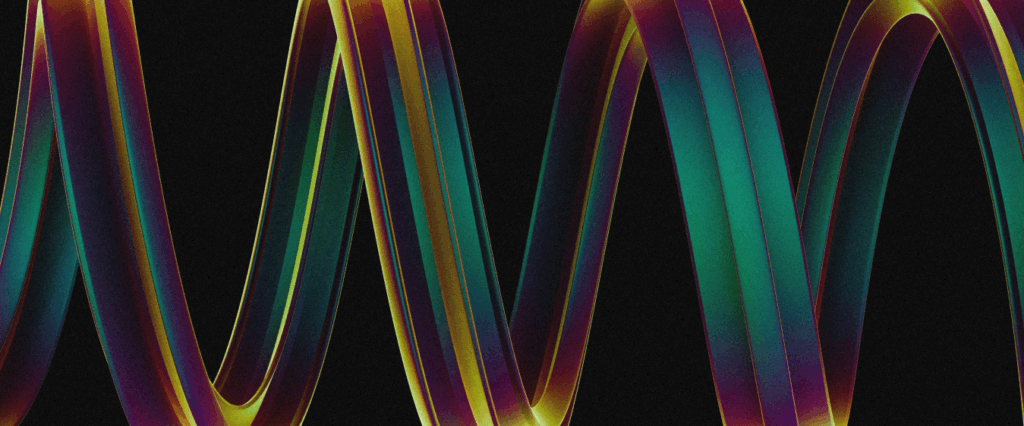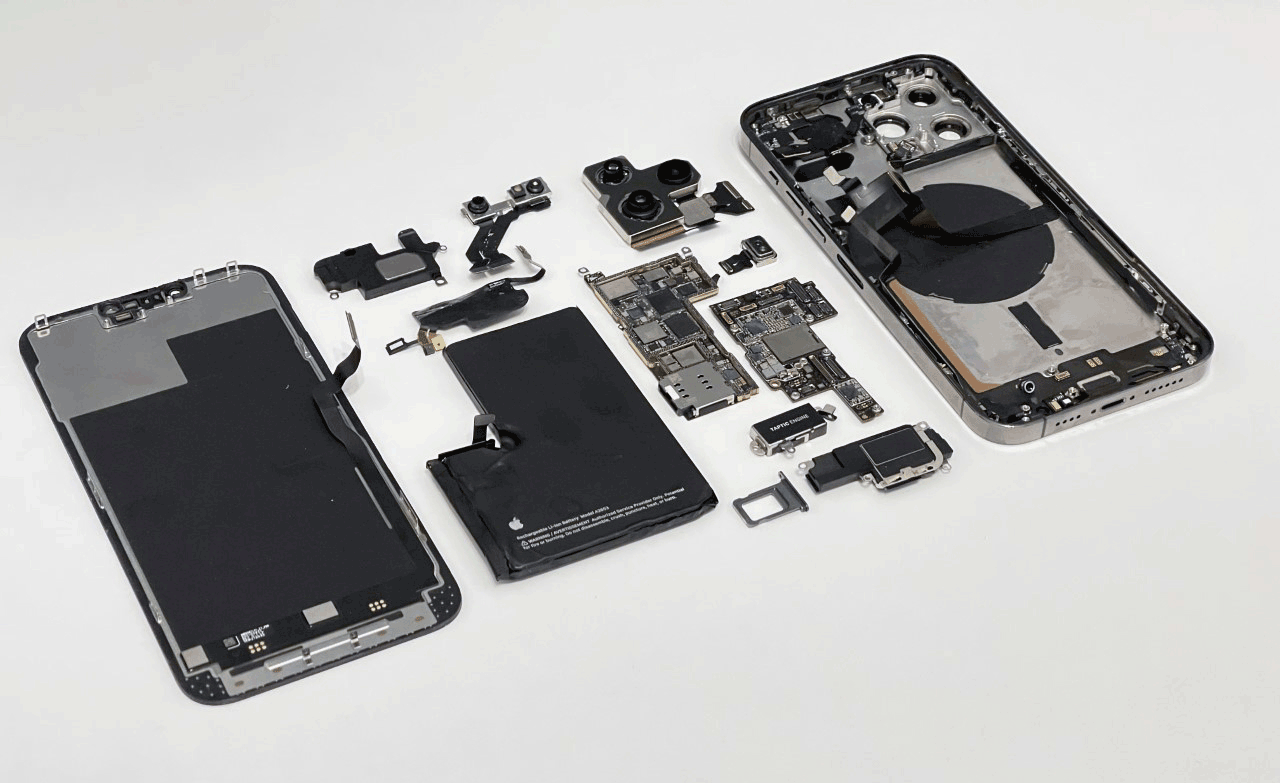On September 14th, 2021, Apple launched the iPhone 13 series comprising iPhone 13 Mini, iPhone 13, iPhone 13 Pro, and iPhone 13 Pro Max versions. Like every year, iPhone has some “industry’s first” features and some “first in an iPhone” features that we are very excited to explore in our teardown analysis. On 24th September, the iPhone series became available for purchase, and we got our hands on the iPhone 13 Pro Max (Model A2484, 128 GB, Graphite color).
Check out our iPhone 13 teardown video!
Design
There are few noticeable physical differences between the iPhone 13 Pro Max and the iPhone 12 Pro Max. One of the first noticeable differences is the smaller notch on the front side which is up to 20% smaller than previous generations. The rear camera lenses on the iPhone 13 Pro Max are much larger than iPhone 12 Pro Max in order to account for the camera improvements which we will discuss in detail in the camera section. The physical buttons on the side edge and the sim card tray are placed slightly higher compared to the iPhone 12 Pro Max. Further, same as last year, the Pro models have a stainless steel frame compared to the aluminum frame for non-pro models.
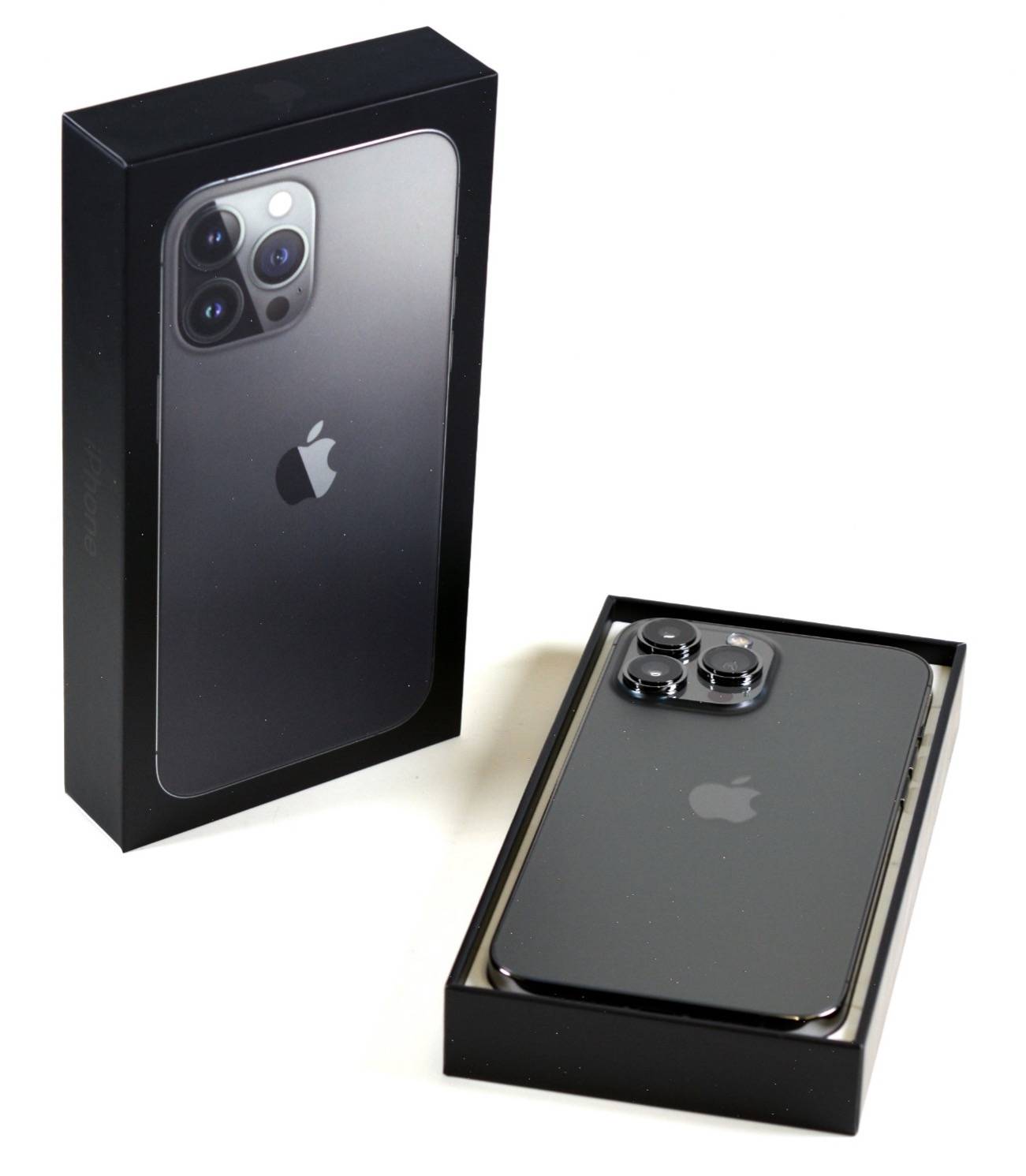
Figure 1: iPhone 13 Pro Max unboxed
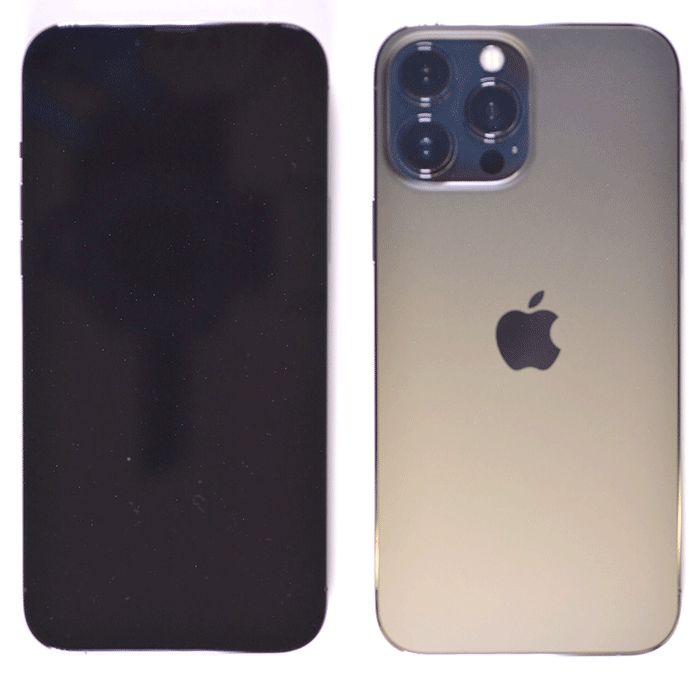
Figure 2: iPhone 13 Pro Max – top and bottom view
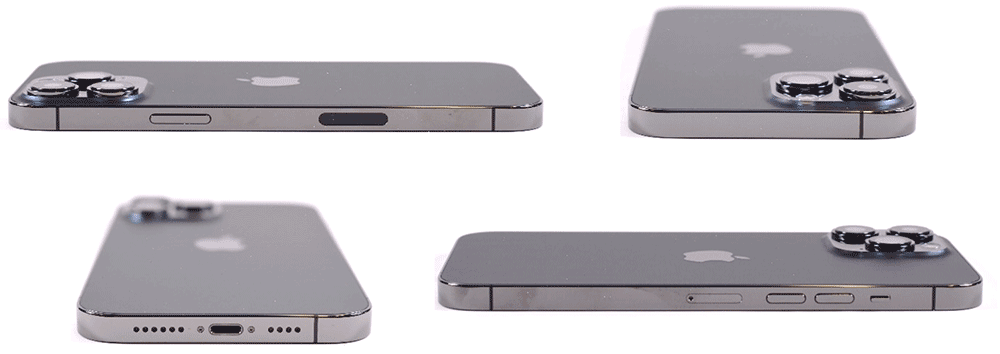
Figure 3: iPhone 13 Pro Max – side view
Teardown
Like every iPhone (since iPhone 5) the teardown of the device is initiated by removing the display screen. The adhesive underneath the screen of iPhone 13 Pro Max was softened upon heating. The screen is separated from rest of the body using a slack to reveal the internal components such as logic boards and battery. iPhone 13 Pro Max is the first to have the processor marking sticker labelled “A15 Bionic”.
The teardown of iPhone 13 Pro Max reveals a lot more connectors on the PCBs of the phone. In addition, Apple has used screws of different sizes which makes the teardown of iPhone 13 Pro Max more challenging compared to the iPhone 12 Pro Max.
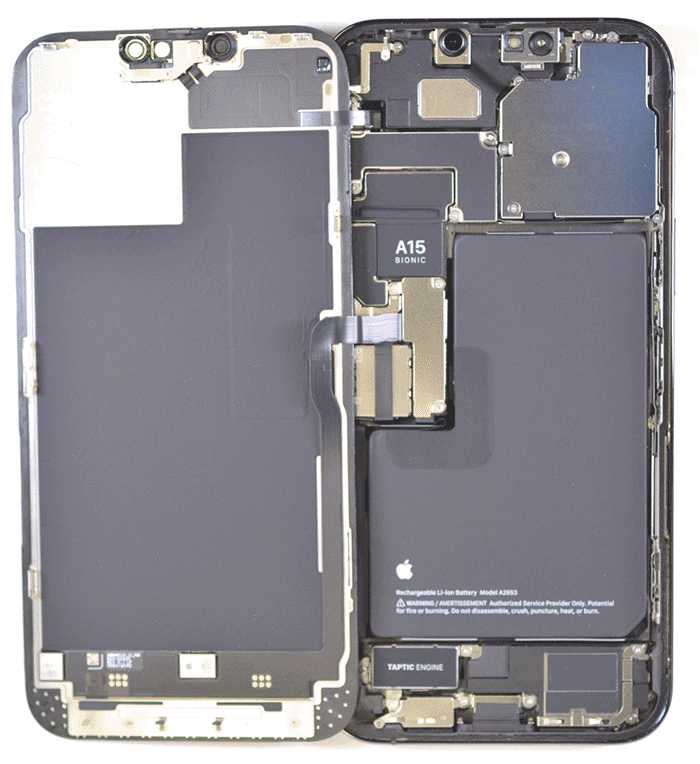
Figure 4: Removal of the screen of the iPhone 13 Pro Max
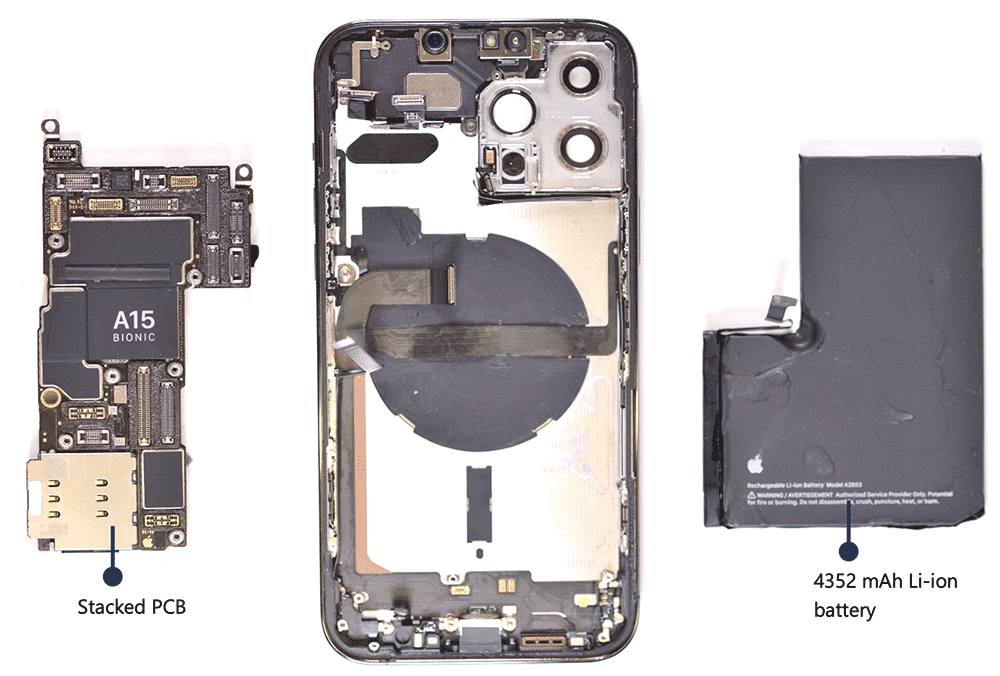
Figure 5: Removal of stacked logic boards, battery, and other components of the iPhone 13 Pro Max
Apple A15 Bionic
The iPhone 13 lineup is powered by Apple’s A15 Bionic chip which features an Apple-designed 64-bit six-core CPU implementing ARMv8 with two high performance cores called Avalanche and four energy efficient cores called Blizzard. The A15 Bionic processor is claimed to be 50% faster than the competitors.
The A15 Bionic processor consists of 15 billion transistors as opposed to 11.8 billion transistors in A14 bionic processor and 8.5 billion transistors in the A13 Bionic chip. The A15 further includes a dedicated neural network hardware which Apple calls 16-core Neural Engine. The Neural Engine can perform 15.8 trillion operations per second, faster than A14’s 11 trillion operations per second (+ 43%). The A15 also includes a new image processor (ISP) with improved computational photography capabilities. Apple also doubled the system cache to 32MB, which would deliver its own performance boost.
The A15 Bionic processor consists of an Apple designed five core GPU for the iPhone 13 Pro, iPhone 13 Pro Max and iPad Mini 6 whereas one core is disabled in the iPhone 13 and iPhone 13 Mini thereby making it a four core GPU for the non-Pro models. The five core GPU is claimed to be 50% faster than the competition whereas the four core GPU is claimed to be 30% faster than the competition.
The A15 Bionic IC is a package-on-package (PoP) structure which comprises of the application processor IC package and a 6GB RAM package for the Pro and Pro Max models whereas the iPhone 13 and iPhone 13 mini has a 4GB RAM. This is similar to the RAM configuration on the iPhone 12 Pro models vs the iPhone 12 non-Pro models.
A15 Bionic chip is manufactured by TSMC using their second generation 5nm FinFET fabrication process. We will know more about the fabrication process once we investigate the application processor.
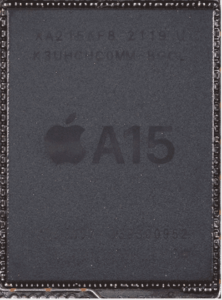
Figure 6: A15 bionic chip
Cameras
Unlike the iPhone 12 Pro series both the iPhone 13 Pro and iPhone 13 Pro Max feature identical camera setup. Similar to the iPhone 12 Pro Max, the iPhone 13 Pro Max features a triple back camera arrangement along with a LiDAR sensor. The iPhone 13 Pro Max rear camera module includes – ultra wide, wide, and telephoto cameras and for the first-time feature – night mode on all 3 cameras.
The ultra-wide camera has an f/1.8 aperture compared to the f/2.4 aperture ultra-wide camera on the iPhone 12 Pro Max, thereby improving photography in low light conditions by up to 92%. However, it maintains a similar 120° field of view aperture to the iPhone 12 Pro lineup. The ultra-wide camera on iPhone 13 Pro Max and iPhone 13 Pro also supports auto focus which was previously not present on the ultra-wide camera. The auto focus on ultra-wide camera also enables the iPhone 13 Pro series’ most under-rated feature called Macro Photography which can magnify subjects with a minimum distance of 2 centimeters to enable detailed close-up pictures.
The telephoto camera features a f/2.8 aperture compared to the f/2.2 aperture on the iPhone 12 Pro Max which enables 3x optical zoom as opposed to 2.5x optical zoom. Thus, allowing a total of 6x optical zoom range and up to 15x digital zoom on the iPhone 13 Pro Max compared to 5x optical zoom range and up to 12x digital zoom on the iPhone 12 Pro Max.
The wide camera on the iPhone 13 Pro Max is Apple’s largest sensor ever which is f/1.5 aperture camera compared to f/1.6 aperture wide camera on the iPhone 12 Pro Max which improves photography by up to 2.2x in low light conditions.
The most advanced stabilization technology on any smartphone called the Sensor-shift is now available across the entire range of iPhone 13 which was previously only present on the wide camera of iPhone 12 Pro Max. Sensor-shift stabilization is a high-end DSLR stabilization approach which applies stabilization to the image sensor rather than the heavier lens (Lens based OIS used in previous generations of iPhone) to precisely control motion in X and Y direction while maintaining sharpness. This enables to cancel both low and high frequency disturbances like hand movements or vibrations in a car.
Apple also introduces Photographic Styles which brings individual preferences into the local pipeline of image processing by applying local edits like a photo editor would but into real time as the phone renders the photo.
The tight integration between Apple’s hardware and software enables for the Apple’s new Cinematic Mode while shooting videos along with Dolby Vision HDR recording. Cinematic Mode enables iPhone 13 Pro and iPhone 13 Pro Max cameras to record videos with a shallow depth of field and add focus transitions for a cinema-grade look.
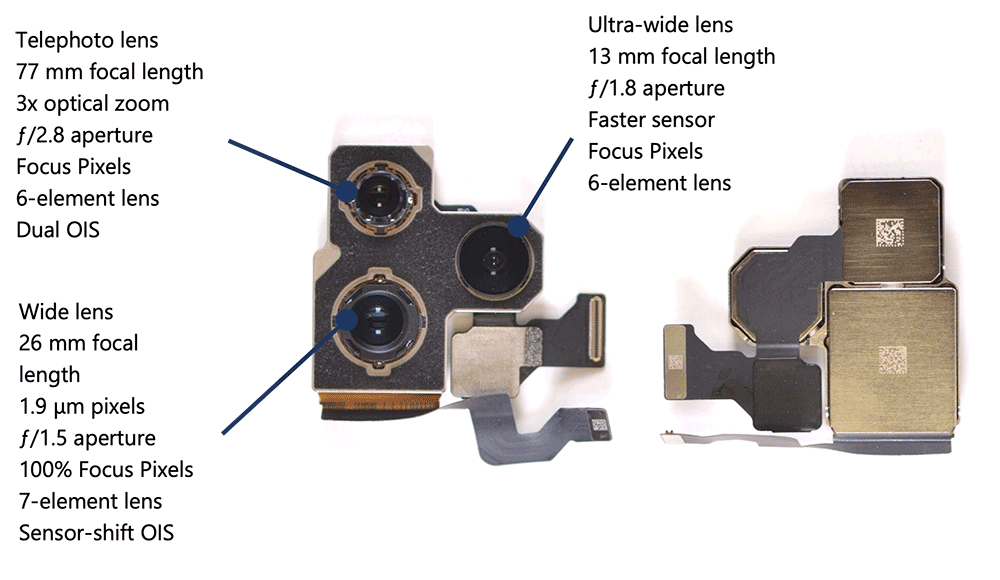
Figure 7: Camera setup – Rear
Similar to the iPhone 12 Pro Max, the front camera setup of iPhone 13 Pro Max includes a 12-megapixel camera, an Infrared camera, flood illuminator and a dot projector. The infrared camera, flood illuminator and the dot projector, also known as the TrueDepth Camera System, work together to enable Face ID on the iPhone. The Face ID system with the components described above is one of the main reasons why Apple can’t remove the notch completely from the iPhone. The selfie camera now supports Smart HDR 4 (smart HDR 3 was supported on iPhone 12 lineup), Deep Fusion, Night Mode, and night mode Portrait shots. Also, we noticed that the Face ID system and front camera is placed closer to each other compared to iPhone 12 Pro Max. This has enabled the reduction in the size of the notch in the display.
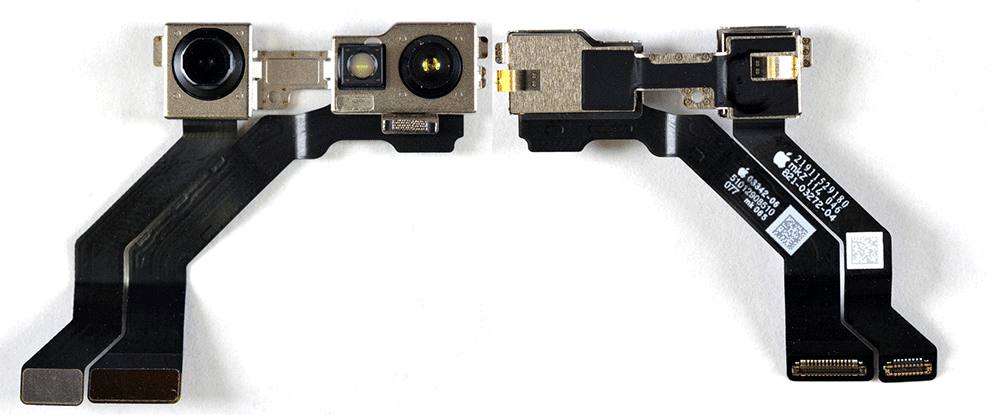
Figure 8: Camera setup – Front
LiDAR system
The iPhone 13 Pro Max also features LiDAR sensor introduced with iPhone 12 Pro series for enhanced augmented reality experiences and also improves camera performances drastically by enhancing low light focus, up to six times faster in low light conditions. Apple introduced night mode portrait photos starting from iPhone 12 Pro series thanks to the presence of LiDAR sensor which enables advanced depth mapping technology. The LiDAR sensor is present at the back of the iPhone 13 Pro Max near the camera lenses, about the same size as the flash. The rear LiDAR sensors work up to a range of 5 meters. This LiDAR sensor seems similar to the one present in the last generation devices.
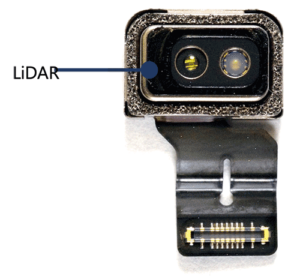
Figure 9: LiDAR sensor camera module
RF system
After Apple implemented 5G technology in their iPhones last year, they improved the 5G connectivity in the new iPhone 13 series. The iPhone 12 lineup last year had support for the most 5G bands (sub-6 GHz, FR1) compared to any other smartphone (see Table 1). Keeping the same tradition this year around, Apple has topped the supported band list with even more new 5G bands, amounting to total of 21 5G NR bands in iPhone 13 Pro Max. For the iPhone 13 models, the supported frequency bands will change based on the geography that you are in, and you can find the frequencies supported by the new iPhone models in your region from Apple website. Same as last year, the USA models provide support for the super-fast 5G mmWave (5G NR, FR2) which provides a higher bandwidth and much higher download/upload speeds. The iPhone 13 series now has support for a new mmWave frequency i.e., n258 (26 GHz) in addition to existing mmWave frequencies n260 (39 GHz), and n261 (28 GHz) in the last generation devices. The iPhone can dynamically switch between the Radio Access Technologies (RAT) based on the user requirements and Radio Access Technology available.
Table 1: Comparison of 5G bands supported by flagship phones
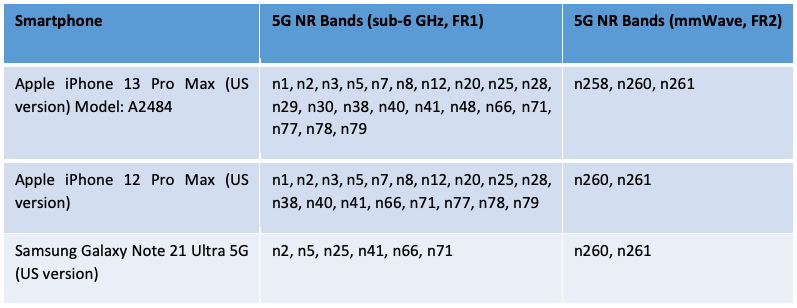
The cellular capability of the iPhone 13 lineup is powered mainly by Qualcomm, same as last year. The teardown of iPhone 13 Pro Max reveals that Apple is using Qualcomm’s Snapdragon X60 5G modem along with PMX60 PMIC which are very likely to be shared among the iPhone 13 lineup. The teardown further reveals that iPhone 13 Pro Max is equipped with Qualcomm SDR868 RF transceiver for 5G NR (sub 6 GHz, FR1), LTE and legacy RATs, which is a part of Snapdragon 888 5G Modem-RF system. The last year’s iPhone was based on Qualcomm’s Snapdragon 865 5G Modem-RF system which comprised SDR865 RF transceiver and X55 Modem.
Further, same as last year, the teardown reveals the presence of Qualcomm SMR526 5G mmWave IF (intermediate frequency) module. The SMR526 IC is part of the 5G mmWave system (5G NR – FR2) and provides the intermediate frequency for the two 5G mmWave antenna modules; one identified at the back of the PCB stack (integrated) and other one at the side of the phone. The placement of these mmWave modules is same as last generation iPhones. Though, the 5G mmWave system is expected to be based on Qualcomm’s 3rd Generation mmWave system, the antenna modules are visibly very different from the Qualcomm’s reference modules. The antenna module (Antenna 1) integrated on the back of the stacked PCB has different antenna element dimensions which probably amounts to additional frequency band support. The antenna module at the side edge of the device (Antenna 2) appears to have antenna elements with a different structure compared to the previous generation side antenna. The antenna elements appear to have a 3D structure which fits into the side edge panel like a Lego. It will be interesting to see these structures in detail once we look inside the modules.
iPhone 13 Pro Max has a similar cut out for the mmWave Antenna 2, below the power button on the right side of the mobile device. The mmWave antenna 1 is present on the stacked PCB structure and has a cut out on the chassis facing the back side as it radiates from the back of the smartphone.
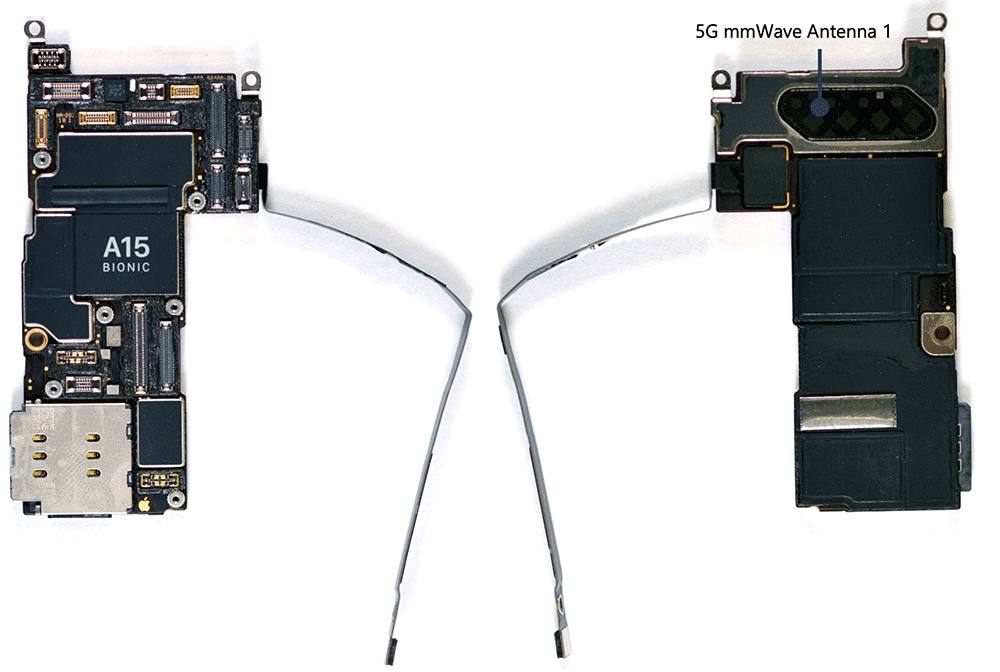
Figure 10: Front-side and back-side of the stacked PCB

Figure 11: iPhone 13 Pro Max – side view
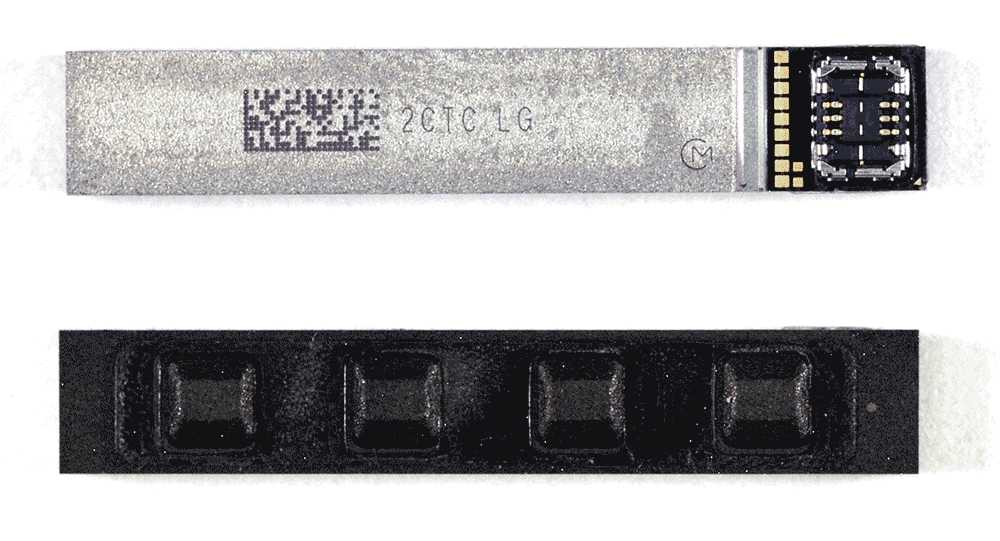
Figure 12: iPhone 13 Pro Max – 5G mmWave antenna 2
Since, the iPhone 13 Pro Max now supports more 5G bands, the smartphone as expected has several new RF Front End Modules (FEM) for 5G NR (sub 6 GHz, FR1), along with LTE and legacy RATs. The iPhone 13 includes FEMs from Avago (Broadcom), Skyworks, Qorvo, Murata etc. The identified list of RFFEM components include Avago (Broadcom) AFEM-8214 front end module which is likely an upgrade from the Avago AFEM-8200 present in the iPhone 12 Pro Max. Further, Skyworks’ SKY5 series RFFEMs for 5G NR includes SKY58270. The RFFEMs from Qorvo and Murata can also be seen on the PCBs. Further, it should be noted that the iPhone 13 models from different geographies are likely to have different RFFEMs due to the differences in the 5G frequency band support. However, the RFFEMs across the iPhone models in the same geography are expected to remain the same. Same as last year, Qualcomm’s QET5100 envelope tracking modules were also identified on the PCB. We will know more about these RFFEMs and their integrated circuit designs during our further detailed analysis.
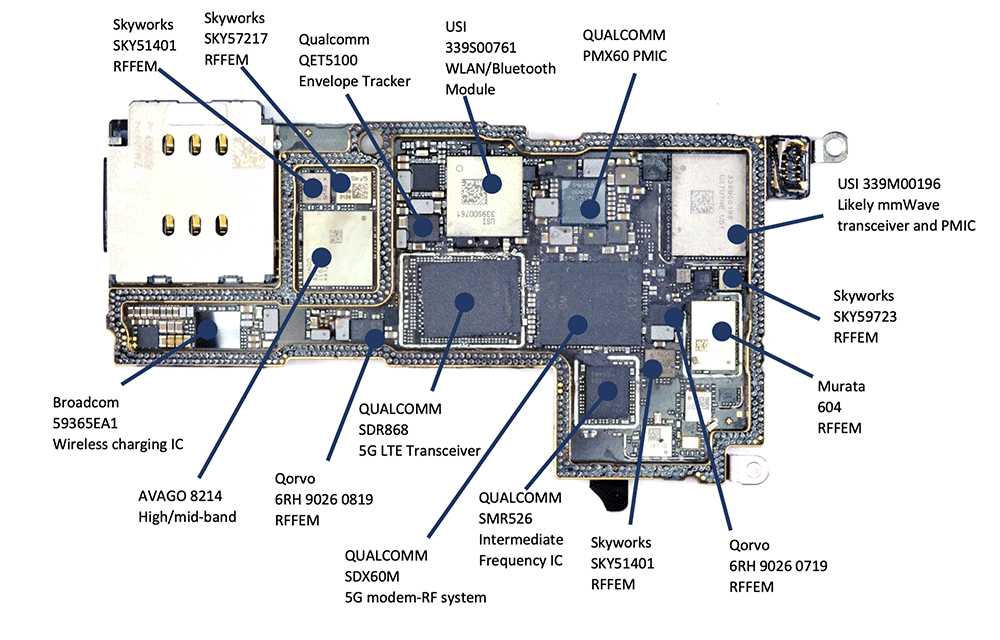
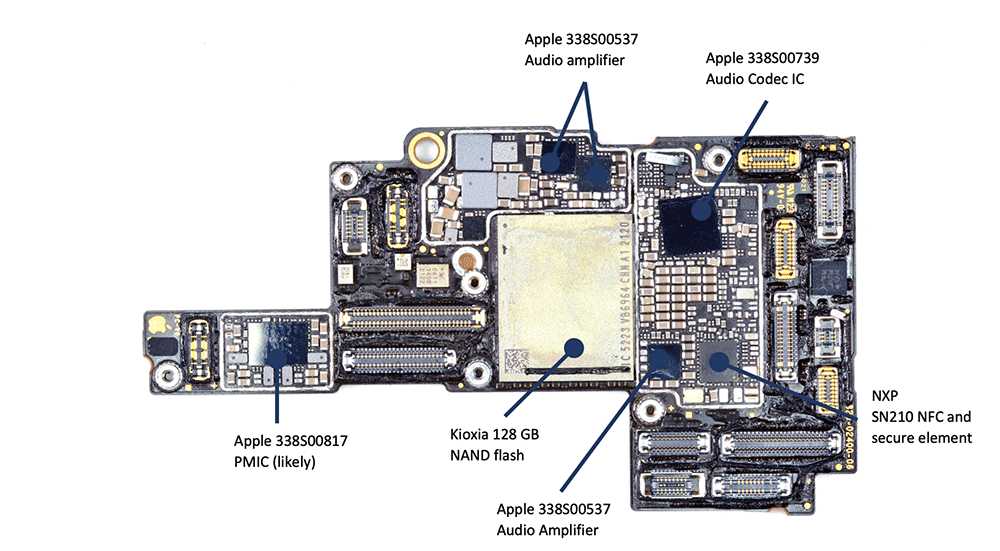
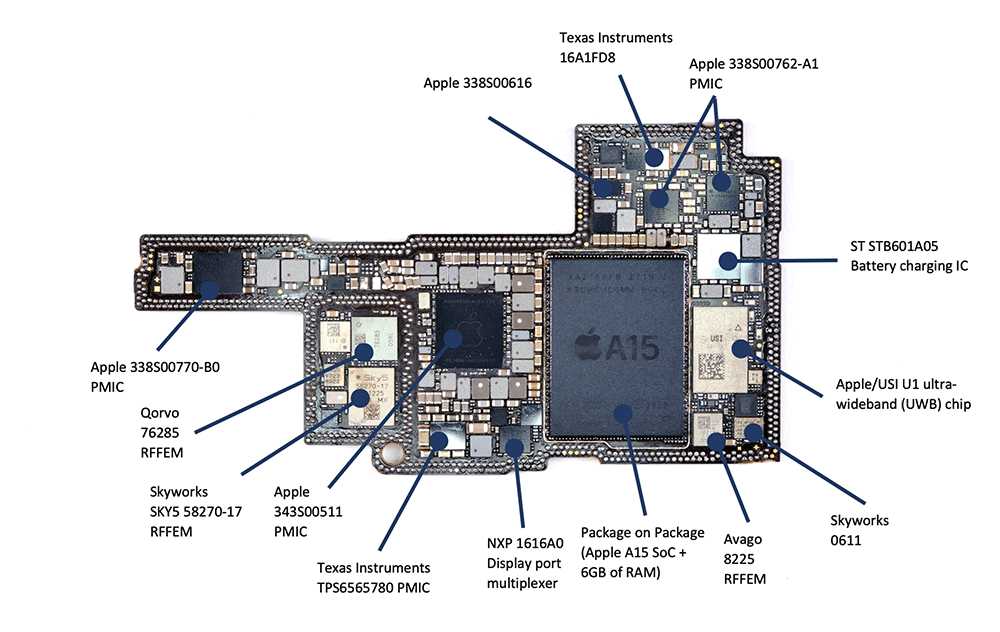
Figure 13: Annotated PCBs (dismantled PCB stack) with identified major ICs
MagSafe
The new iPhone 13 lineup features MagSafe charging which Apple first introduced with the iPhone 12 lineup. There were speculations of Apple implementing stronger magnets with the 2021 line up, however our teardown of iPhone 13 Pro Max revealed similar magnets as compared to the ones used on iPhone 12 series.
MagSafe charging makes use of magnets to allow for easier Qi-charging by snapping on to the back of the new iPhones. The teardown of the iPhone 13 Pro Max reveals the presence of magnetic ring embedded under the wireless charging coil along with a vertical strip of magnet present below the ring which is identical to the system implemented on the iPhone 12 series. The wireless charging further houses a wireless charging coil along with the NFC antenna used for Apple Pay transactions.
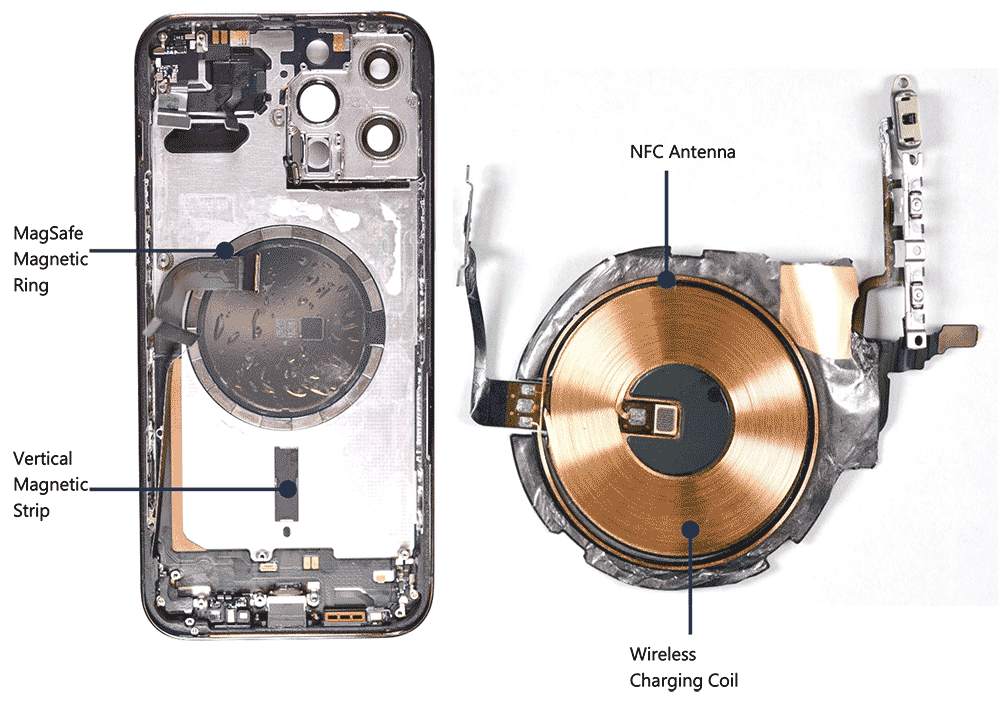
Figure 14: MagSafe system
Battery
All four models of the new iPhone 13 series feature a larger battery compared to previous generations of the iPhone 12 lineup. The iPhone 13 Pro Max is equipped with a 4352 mAH battery making it the largest battery amongst the iPhone 13 lineup. The iPhone 12 Pro Max featured a lower capacity battery – 3687 mAH whereas the iPhone 11 Pro Max featured a 3969 mAH capacity battery. Apple’s technical specifications mention that the iPhone 13 Pro Max has a video playback of up to 28 hours as compared to the 20 hours of video playback on iPhone 12 Pro Max and iPhone 11 Pro Max.
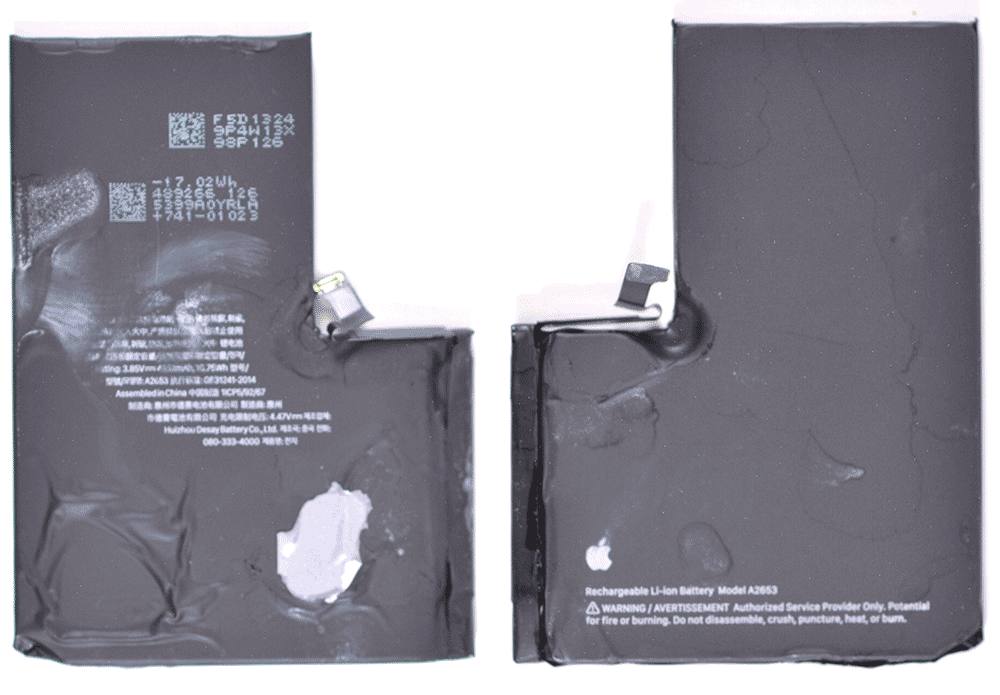
Figure 15: Battery
Table 2: Battery comparison of iPhone models

Display
With the iPhone 13 Pro and iPhone 13 Pro Max, Apple finally brought their ProMotion display technology which was previously seen in iPad Pro. ProMotion display technology allows iPhone 13 Pro and iPhone 13 Pro Max to refresh screen content at the rate of 120Hz making the interface much smoother than the iPhone 12 lineup. Similar to the iPhone 12 Pro Max, iPhone 13 Pro Max is equipped with 6.7” OLED Super Retina XDR display which is slightly larger than the display in iPhone 11 Pro Max. The display supports brightness up to 1200 nits and comprises more pixels compared to the iPhone 11 Pro.
The display of iPhone 13 series also features Ceramic Shield introduced by Apple on the iPhone 12 lineup which is a cover glass that has nano-ceramic crystals infused into the front-glass of the iPhone to improve its durability.
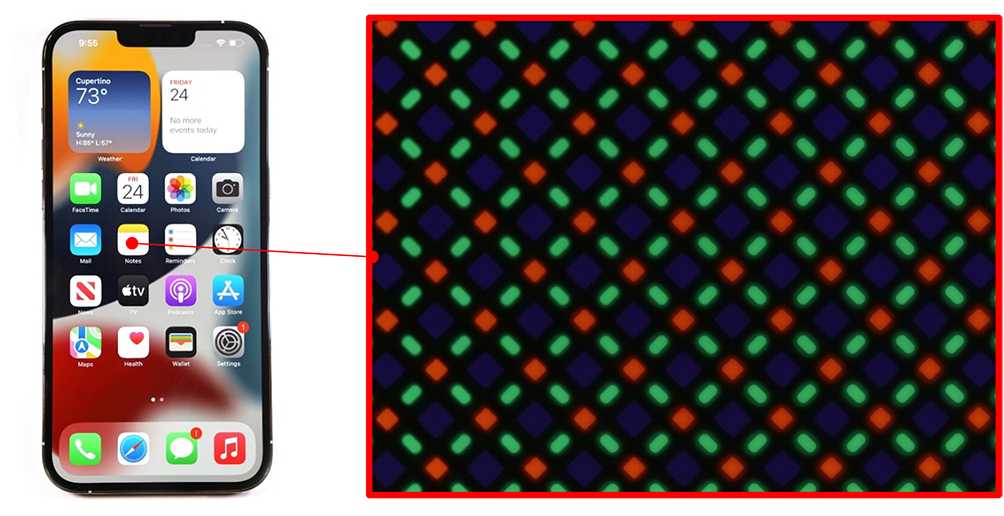
Figure 16: Pixel layout of the OLED screen of the iPhone 13 Pro Max
Table 3: Comparison between iPhone 12 Pro series and iPhone 13 series
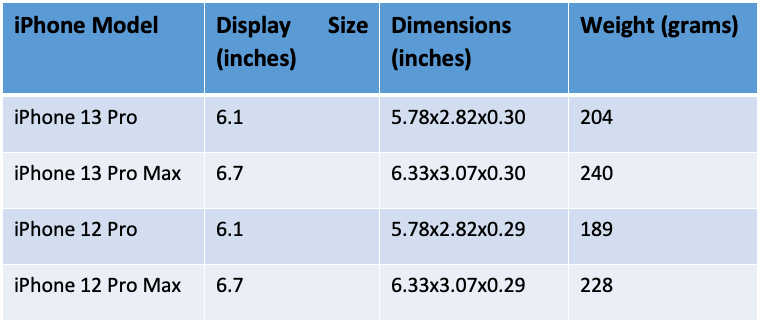
Ongoing Analysis
All the information provided here is based on the preliminary teardown analysis of the phone. The information for the ICs is based on the package markings wherever identified, known functions of the identified components, logical reasoning and, to some degree of assumptions. We will gather more conclusive information during our detailed teardown analysis on the iPhone 13 Pro Max.
In the meantime, check out our teardown of the iPhone 12 Pro Max to see the previous changes made to Apple’s prior model, not highlighted in this report.




